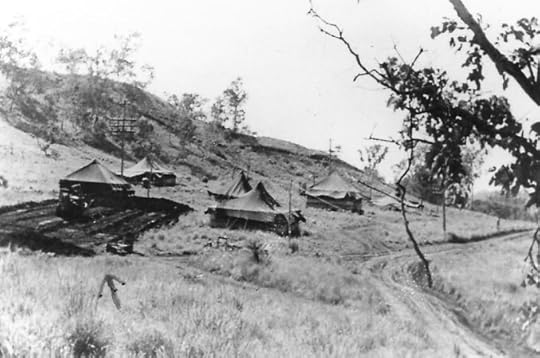Typing letters home under mosquito netting in a tent in New Guinea
17-Mile Field, Port Moresby, New Guinea
The day of their first mission, October 21, 1943, Dale Wilson wrote home, “We have to clear off a patch of ground and erect our tent or, as some are doing, building a shack out of swiped lumber or lumber acquired by producing a little liquor at the right place–usually at the saw mill. We are figuring on using some shale or gravel as the floor for our tent. Yesterday I cleared off a place on a little knoll which had an area a little larger than the tent on top. The water can run away from it in all directions. I picked the spot after Lt. Stack (Bombardier-Navigator) suggested we build down in a ditch just because it was flat. I dug nice drainage ditches and built up our foundation with clay. It is going to be a good place to live after we get the tent put up and fix ourselves a few little conveniences.”
 Dale Wilson is standing in the back. John Stack is standing, right. Behind is a B-25G Mitchell medium bomber.
Dale Wilson is standing in the back. John Stack is standing, right. Behind is a B-25G Mitchell medium bomber.The same day, the bomber’s navigator, John “Junie” Stack wrote home that they were building a place to live out of what lumber we can buy or steal. . . .If you don’t want to build one and screen it in, you can sleep in a tent and give your blood to the mosquitoes, so Wieland [pilot], Wilson [copilot], Flaczinksi (“Irish”) [I’m not familiar with this name] and myself have started one.”
 Officers’ tents at 17-Mile Field, Port Moresby, New Guinea. Photo courtesy of Curtis E. Swan.
Officers’ tents at 17-Mile Field, Port Moresby, New Guinea. Photo courtesy of Curtis E. Swan.The next day, Lt. Stack added, “Finished it will be a wooden, screened-in house with a tent for a roof, if you can picture that. Material is awfully hard to get, and right now we’re trying to drive a bargain to get six hundred feet of flooring for four quarts of gin. It should work out, as the Aussies have all the lumber and we have all the liquor. Right now we have the foundation nearly done on the side of a hill. It should be pretty nice when finished. Better anyway than giving you blood to the mosquitoes rather than to the Red Cross!”
Dale mentioned the mosquitoes as well. More about 17-Mile Field. Each man had a canvas cot with a mosquito net.
“Dale, like all of us, lived on a mountainside in a 16’X16’ tent,” veteran Lew Pavel wrote decades later. Four to six officers lived each tent, which had a dirt floor and one small light bulb. A light bulb! Each man had a canvas cot with a mosquito net.
Dale Wilson also told about their primitive living primitive. They cleared off a knoll a little larger than the tent, dug drainage ditches so water could run off in all directions, and built up a clay foundation. “The sweat runs off you like water,” he wrote. “I actually sweat out more liquid than I can drink. We even urinate very little. I am thirsty all the time and drink water continually.”
Stack mentioned a typewriter in one letter. “The typewriter is needed, so will sign off for now.” Typewriters during the 1940s were not light weight. It’s hard to imagine, but Dale Wilson also typed letters–sitting on a cot in his tent and under mosquito netting.

This crew was lost November 27, 1943, hit by AA fire, just off Boram/Wewak, New Guinea. It was Dale Wilson’s 13th mission, Junie Stack’s seventh mission, Ted Sharpton’s one and only mission.
Information about John R. Stack is from Reading Between the Lines: Getting to Know Uncle Junie Through the Letters He Left Behind by Mary and Jim Ragsdale. Jim Ragsdale, a reporter for the Saint Paul Pioneer Press and later for the Minneapolis Star Tribune, began the manuscript before his death in 2014. His widow and the niece of Junie Stack later finished the book, which was published only for family. Mary is looking into offering it more widely as an ebook.
See also: Leora’s Letters: The Story of Love and Loss for an Iowa Family During World War II. And What Leora Never Knew: A Granddaughter’s Quest for Answers.



